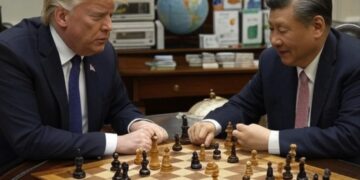In a historic convergence of milestones, President Donald Trump marked the U.S. Army’s 250th anniversary, his 79th birthday, and Flag Day with a grand military parade along Constitution Avenue yesterday. The event, one of the largest military displays in recent U.S. history, drew thousands to the National Mall for a daylong celebration of the Army’s legacy, while sparking debate over its cost and implications.
The parade featured approximately 6,600 soldiers, 150 military vehicles, 50 aircraft flyovers, and historical reenactors showcasing the Army’s evolution since its founding on June 14, 1775. Highlights included performances by the Army’s Golden Knights parachute team, who presented Trump with a flag, and a mass enlistment ceremony presided over by the President. Trump’s remarks lauded the Army’s “unmatched courage and sacrifice,” emphasizing its role in shaping the nation and projecting strength globally.
The day’s festivities extended beyond the parade, with a festival on the National Mall featuring military bands, equipment displays, and a fitness competition. A fireworks display capped the evening, drawing cheers from attendees. The Army framed the event as a capstone to its yearlong 250th anniversary campaign, aimed at boosting recruitment and public engagement in an era of evolving national security challenges.
Cost and Controversy
Estimated to cost between $25 million and $45 million, the parade has ignited debate. Critics, including congressional Democrats and advocacy groups like No Kings, labeled it an extravagant use of taxpayer funds and a politicized spectacle blending Trump’s birthday with a national institution’s milestone. Comparisons to authoritarian displays surfaced, with some arguing it risks eroding public trust in the military’s apolitical stance. Protests occurred nationwide, though major demonstrations avoided D.C., likely to sidestep heightened security.
Supporters, including Pentagon officials and Trump allies, defended the event as a fitting tribute to the Army’s storied history and a strategic recruitment tool. The Army noted that the parade was a late addition to pre-planned anniversary events, initiated at Trump’s direction, but maintained that it aligned with the broader goal of honoring service members and inspiring future generations.
Stakeholder Implications
For stakeholders in defense, government, and civic organizations, the event underscores ongoing tensions around military symbolism in polarized times. The parade’s scale highlights the administration’s focus on projecting strength, potentially signaling robust defense spending priorities. However, its cost and optics raise questions about resource allocation amid competing national needs. Businesses tied to defense contracting may see opportunities in heightened military visibility, while civic groups advocating for government transparency will likely push for clearer accounting of the event’s expenses.
As the Army looks to modernize and attract talent in a competitive job market, the celebration aimed to galvanize public support. Whether it achieves this goal or deepens divides remains a critical question for stakeholders monitoring the intersection of policy, perception, and national identity.
Looking Ahead
The Army’s 250th anniversary will continue with smaller events through 2025, focusing on community outreach and technological innovation. For now, the D.C. parade stands as a bold, divisive moment—one that stakeholders across sectors will analyze for its long-term impact on military-civilian relations and national discourse.





































